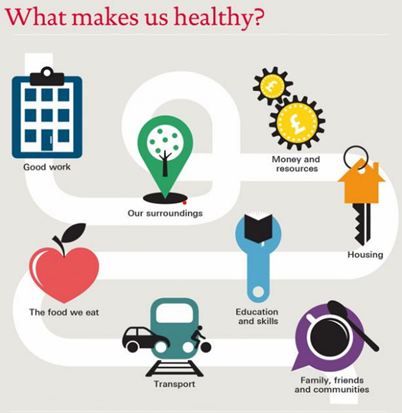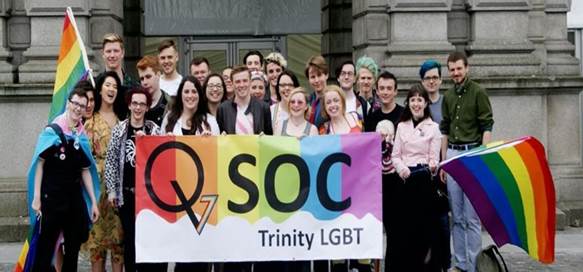 Housing and Health
Housing and Health
By recent graduate, Eleanor Colreavy
Housing and the rising cost of living are the most dominant concerns of young people in Ireland (NYCI Report, 2024)
Starting university is a major period of transition requiring young people to adapt to new environments and social situations.1 Where you live, who you live with, and the quality of your living environment can have profound effects on your mental and physical health. Despite this, when asked what they feel are the ‘top three most important issues in Ireland’, housing and the rising prices/inflation/cost of living are the most dominant concerns of young people in Ireland; 67% and 62% respectively.2
For college students, navigating the challenges of housing can be a pivotal part of ensuring a healthy and successful academic journey. Whether you're living in a dormitory, sharing an off-campus apartment, or commuting from home, your living situation plays a crucial role in your overall well-being. You might be a first year adjusting to dorm life or a post-graduate seeking off-campus housing; but understanding the link between your home and your health is vital for maintaining balance and well-being throughout your college years.
Housing and Mental Health – The Crucial Connection
Adequate, suitable, and affordable housing contributes to our mental well-being. It leads to increased personal safety and help decrease stress, leading to improved sleep and diet. All of these factors result in better mental health outcomes.
 Housing is recognised as one of the main domains relating to individual well-being, particularly amongst higher education students.6 In fact, one study previously highlighted that living arrangements were significantly linked to mental health in 90% of students at a single US university. 7 Despite this, nearly half (48%) of young people in Ireland are currently dissatisfied with their current housing situation.2
Housing is recognised as one of the main domains relating to individual well-being, particularly amongst higher education students.6 In fact, one study previously highlighted that living arrangements were significantly linked to mental health in 90% of students at a single US university. 7 Despite this, nearly half (48%) of young people in Ireland are currently dissatisfied with their current housing situation.2
Adequate, suitable and affordable housing contributes to our mental well-being. It leads to increased personal safety and helps decrease stress, leading to improved sleep and diet. All of these factors result in better mental health outcomes.8 Poor housing conditions can affect mental health.9 People living in housing with more problems have a greater likelihood of experiencing mental ill health10, while physical improvements to housing improves mental health.11,12 It is not just the conditions of a home, however, that can have a negative impact on a person’s health. Housing insecurity, risks of homelessness and evictions, or unaffordable housing costs have all been shown to impact mental health.13
Affordable homeownership can have mental health benefits by offering people control over their environment.14 When we cannot find or afford a place to call our own, it can create a sense of insecurity and powerlessness, leading to feelings of fear, anger, resentment, and loneliness.9 In fact, students not owning the room they are living in have previously demonstrated higher psychological distress, regardless of their parental financial support.15 However, the ability to create a sense of independence appears to be increasingly difficult to achieve - mainly due to the inability of many to move out of their family homes for a variety of reasons, including high rents.2 For example, The NYCI Report (2024)2 describes examples of young people in the process of building cabins at the end of their family home to create a sense of distance and space from their family.
Housing and the LGTBQI+ Community
LGBTQI+ youth are at greater risk of homelessness as they are affected both by the factors which precipitate homelessness among the young population-at-large, and by additional challenges related to their sexuality and/or gender identity which can indirectly result in homelessness.
 Youth homelessness has been increasing in recent years (National Youth Council of Ireland, 2024). LGBTQI+ youth are at greater risk of homelessness as they are affected both by the factors which precipitate homelessness among the young population-at-large, and by additional challenges related to their sexuality and/or gender identity which can directly or indirectly result in homelessness (Norris & Quilty, 2021). LGBTQI+ youth experiencing homelessness may have the additional trigger of being asked to leave the family home after coming out. Accessing homeless services or accommodation becomes precarious for many reasons. For example, LGBTQI+ individuals engaging with those services are often hesitant to come out to the service for fear of discrimination or prior traumatic experience (Norris & Quilty, 2021). All these situations and triggers impact mental health.
Youth homelessness has been increasing in recent years (National Youth Council of Ireland, 2024). LGBTQI+ youth are at greater risk of homelessness as they are affected both by the factors which precipitate homelessness among the young population-at-large, and by additional challenges related to their sexuality and/or gender identity which can directly or indirectly result in homelessness (Norris & Quilty, 2021). LGBTQI+ youth experiencing homelessness may have the additional trigger of being asked to leave the family home after coming out. Accessing homeless services or accommodation becomes precarious for many reasons. For example, LGBTQI+ individuals engaging with those services are often hesitant to come out to the service for fear of discrimination or prior traumatic experience (Norris & Quilty, 2021). All these situations and triggers impact mental health.
Not being accepted by friends, family, or your community of origin is challenging, even traumatic. This trauma is compounded if you cannot find secure accommodation because of your gender identity/sexuality. Many LGBTQI+ individuals need to be, “‘hyper vigilant’ or ‘hyper situationally aware’ due to negative responses to their sexuality and gender identity. A private space provides respite from this, which is vital for their mental health (Norris & Quilty, 2021). Not having their own space increases anxiety, exhaustion, and impacts mental health.
To better support our LGBTQI+ community we need to become more aware of direct and indirect discrimination in accessing housing, retaining housing, and accessing homeless services that are appropriate. This requires both attitudinal change and further research and data gathering to identify the needs of the community.
Want to do something about Housing and Health?
If you’d like to take action, check out our manual on political organising.
Bibliography
1 Richardson, A., King, S., Garrett, R., & Wrench, A. (2012). Thriving or just surviving? Exploring student strategies for a smoother transition to university. A Practice Report. Student Success, 3(2), 87. https://fyhejournal.com/article/download/132/138/132-1-722-1-10-20120727.pdf
2 National Youth Council of Ireland (2024). State of our young nation: A report into the lives of Irish 18-29-year-olds. https://www.youth.ie/documents/state-of-our-young-nation-a-report-into-the-lives-of-irish-18-29-year-olds/
3 World Health Organization. Regional Office for, E. (2014). Combined or multiple exposure to health stressors in indoor built environments: an evidence-based review prepared for the WHO training workshop “Multiple environmental exposures and risks”: 16–18 October 2013, Bonn, Germany. https://iris.who.int/handle/10665/350495
4 Smith, M., Albanese, F., & Truder, J. (2014). A Roof Over My Head: The final report of the Sustain project London: Crisis and Shelter.
5 Piper, R., & Tressler, R. (2017). Student living: collaborating to support mental health in university accommodation. London: Student Minds.
6 Franzoi, I. G., Carnevale, G., Sauta, M. D., & Granieri, A. (2023). Housing conditions and psychological distress among higher education students: a systematic literature review. Journal of Further and Higher Education, 47(2), 229-241. https://doi.org/10.1080/0309877X.2022.2102416
7 O’Connell, V. A. (2014). The Healthy College Student: The Impact of Daily Routines on Illness Burden. Sage Open, 4(3). https://doi.org/10.1177/2158244014547181
8 Canadian Mental Health Association Ontario (2014, March). Housing and Mental Health. https://ontario.cmha.ca/documents/housing-and-mental-health/
9 Çalıyurt O. The Mental Health Consequences of the Global Housing Crisis. Alpha Psychiatry. 2022 Nov 1;23(6):264-265. https://doi.org/10.5152%2Falphapsychiatry.2022.17112022
10 Pevalin, D. J., Taylor, M. P., & Todd, J. (2008). The dynamics of unhealthy housing in the UK: A panel data analysis. Housing studies, 23(5), 679-695. https://doi.org/10.1080/02673030802253848
11 Curl, A., Kearns, A., Mason, P., Egan, M., Tannahill, C., & Ellaway, A. (2015). Physical and mental health outcomes following housing improvements: evidence from the GoWell study. J Epidemiol Community Health, 69(1), 12-19. https://doi.org/10.1136/jech-2014-204064
12 Willand, N., Ridley, I., & Maller, C. (2015). Towards explaining the health impacts of residential energy efficiency interventions–A realist review. Part 1: Pathways. Social science & medicine, 133, 191-201. https://doi.org/10.1016/j.socscimed.2015.02.005
13 Kineara (n.d.). How housing affects our health. https://kineara.co.uk/how-housing-effects-our-health/).
14 Maqbool, N., Viveiros, J., & Ault, M. (2015). The Impacts of Affordable Housing on Health: A Research Summary. https://nhc.org/wp-content/uploads/2017/03/The-Impacts-of-Affordable-Housing-on-Health-A-Research-Summary.pdf)
15 Verschuur, M. J., Eurelings-Bontekoe, E. H., & Spinhoven, P. (2004). Associations among homesickness, anger, anxiety, and depression. Psychological reports, 94(3_suppl), 1155-1170. https://doi.org/10.2466/pr0.94.3c.1155-1170
16. World Health Organization. (2018). WHO housing and health guidelines.
Commission on Social Determinants of Health. (2008). Closing the gap in a generation: health equity through action on the social determinants of health: final report of the commission on social determinants of health. World Health Organization.
Marmot, M. (2013). Fair society, healthy lives. Fair society, healthy lives, 1-74.
Norris, M. and Quilty, A. (2021) ‘Unreal, unsheltered, unseen, unrecorded: the multiple invisibilities of LGBTQI+ homeless youth’ in Critical Social Policy, Vo.l41(3):468-490. https://www.focusireland.ie/wp-content/uploads/2021/09/LGBTQI-Youth-Homelessness-Report_FINAL-VERSION.pdf

